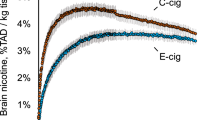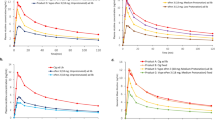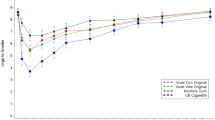Abstract
Rapid brain accumulation is critical for the acute reinforcing effects of nicotine. Although nicotine formulation (free-base vs. protonated or salt) in electronic cigarette (E-cig) liquid affects user satisfaction, its impact on brain nicotine accumulation (BNA) from E-cig use has not been evaluated in comparison with traditional combustible cigarettes (C-cigs) using a within-subjects design. BNA was directly assessed with 29 adult dual users (13 females) of E-cigs and C-cigs, using [11C]nicotine and positron emission tomography (PET). Participants underwent two 15-min upper body (from chest to head) scanning sessions during which they inhaled a single puff of [11C]nicotine-labeled vapor from E-cigs with free-base nicotine or C-cig smoke in a randomized order. Seventeen of them also went through another session during which they inhaled from E-cigs with nicotine salt. A full-body scan was also conducted at each session to measure total absorbed dose of [11C]nicotine. Mean maximum nicotine concentration (Cmax) in brain following inhalation of free-base nicotine E-cig vapor was 19% and 15% lower relative to C-cig smoke and nicotine salt E-cig vapor (ps = 0.014 and 0.043, respectively). The Cmax values did not differ significantly between the C-cig and nicotine salt E-cig. Mean values of time to the maximum concentration (Tmax) were not significantly different between the two types of E-cig, but they were 64% and 40% longer than that for C-cig smoking (ps = 0.0005 and 0.004, respectively). Mean Cmax with C-cigs and free-base nicotine E-cigs were greater in females relative to males and correlated with T1/2 of lung nicotine clearance and participants’ pack-years. These results suggest that while E-cigs with free-base nicotine formulation can deliver nicotine rapidly to the brain, those with nicotine salt formulation are capable of even more efficient brain nicotine delivery closely resembling combustible cigarettes. Therefore, nicotine formulation or pH in E-liquid should be considered in evaluation of E-cigs in terms of abuse liability and potential in substituting for combustible cigarettes.
This is a preview of subscription content, access via your institution
Access options
Subscribe to this journal
Receive 13 print issues and online access
$259.00 per year
only $19.92 per issue
Buy this article
- Purchase on Springer Link
- Instant access to full article PDF
Prices may be subject to local taxes which are calculated during checkout



Similar content being viewed by others
Data availability
The data underlying this article will be shared on reasonable request to the corresponding author.
References
Ali FRM, Seidenberg AB, Crane E, Seaman E, Tynan MA, Marynak K. E-cigarette unit sales by product and flavor type, and top-selling brands, United States, 2020–2022. MMWR Morb Mortal Wkly Rep. 2023;72:672–77.
Abrams DB, Glasser AM, Pearson JL, Villanti AC, Collins LK, Niaura RS. Harm minimization and tobacco control: reframing societal views of nicotine use to rapidly save lives. Annu Rev Public Health. 2018;39:193–213.
Farsalinos K. Electronic cigarettes: an aid in smoking cessation, or a new health hazard? Ther Adv Respir Dis. 2018;12:1753465817744960-60.
Benowitz NL. Clinical pharmacology of nicotine: implications for understanding, preventing, and treating tobacco addiction. Clin Pharm Ther. 2008;83:531–41.
Carter LP, Stitzer ML, Henningfield JE, O’Connor RJ, Cummings KM, Hatsukami DK. Abuse liability assessment of tobacco products including potential reduced exposure products. Cancer Epidemiol, Biomark Prev. 2009;18:3241–62.
Henningfield JE, Keenan RM. Nicotine delivery kinetics and abuse liability. J Consult Clin Psychol. 1993;61:743–50.
Gholap VV, Kosmider L, Golshahi L, Halquist MS. Nicotine forms: why and how do they matter in nicotine delivery from electronic cigarettes? Expert Opin Drug Deliv. 2020;17:1727–36.
Stepanov I, Fujioka N. Bringing attention to e-cigarette pH as an important element for research and regulation. Tob Control. 2015;24:413–4.
Wall A, Roslin S, Borg B, McDermott S, Walele T, Nahde T, et al. E-cigarette aerosol deposition and disposition of [11C]nicotine using positron emission tomography: a comparison of nicotine uptake in lungs and brain using two different nicotine formulations. Pharmaceuticals. 2022;15:367.
El-Hellani A, El-Hage R, Baalbaki R, Salman R, Talih S, Shihadeh A, et al. Free-base and protonated nicotine in electronic cigarette liquids and aerosols. Chem Res Toxicol. 2015;28:1532–7.
Armitage AK, Dixon M, Frost BE, Mariner DC, Sinclair NM. The effect of tobacco blend additives on the retention of nicotine and solanesol in the human respiratory tract and on subsequent plasma nicotine concentrations during cigarette smoking. Chem Res Toxicol. 2004;17:537–44.
Benowitz NL. Clinical pharmacology of inhaled drugs of abuse: implications in understanding nicotine dependence. NIDA Res Monogr. 1990;99:12–29.
Pankow JF. A consideration of the role of gas/particle partitioning in the deposition of nicotine and other tobacco smoke compounds in the respiratory tract. Chem Res Toxicol. 2001;14:1465–81.
Rose JE, Mukhin AG, Lokitz SJ, Turkington TG, Herskovic J, Behm FM, et al. Kinetics of brain nicotine accumulation in dependent and nondependent smokers assessed with PET and cigarettes containing 11C-nicotine. Proc Natl Acad Sci USA. 2010;107:5190–5.
Zuo Y, Mukhin AG, Garg S, Nazih R, Behm FM, Garg PK, et al. Sex-specific effects of cigarette mentholation on brain nicotine accumulation and smoking behavior. Neuropsychopharmacology. 2015;40:884–92.
Solingapuram Sai KK, Zuo Y, Rose JE, Garg PK, Garg S, Nazih R, et al. Rapid brain nicotine uptake from electronic cigarettes. J Nucl Med. 2020;61:928–30.
Zuo Y, Mukhin AG, Berg H, Morgan JD, Mintz A, Rose JE, et al. Comparison of brain nicotine uptake from electronic cigarettes and combustible cigarettes. Neuropsychopharmacology. 2022;47:1939–44.
Heatherton TF, Kozlowski LT, Frecker RC, Fagerström KO. The Fagerström test for nicotine dependence: a revision of the Fagerström tolerance questionnaire. Br J Addict. 1991;86:1119–27.
Foulds J, Veldheer S, Yingst J, Hrabovsky S, Wilson SJ, Nichols TT, et al. Development of a questionnaire for assessing dependence on electronic cigarettes among a large sample of ex-smoking E-cigarette users. Nicotine Tob Res. 2015;17:186–92.
Farsalinos KE, Romagna G, Tsiapras D, Kyrzopoulos S, Voudris V. Evaluation of electronic cigarette use (vaping) topography and estimation of liquid consumption: implications for research protocol standards definition and for public health authorities’ regulation. Int J Environ Res Public Health. 2013;10:2500–14.
Zuo Y, Garg PK, Nazih R, Garg S, Rose JE, Murugesan T, et al. A programmable smoke delivery device for PET imaging with cigarettes containing (11)C-nicotine. J Neurosci Methods. 2017;283:55–61.
Halldin C, Någren K, Swahn CG, Långström B, Nybäck H. (S)- and (R)-[11C]nicotine and the metabolite (R/S)-[11C]cotinine. Preparation, metabolite studies and in vivo distribution in the human brain using PET. Int J Rad Appl Instrum B. 1992;19:871–80.
Garg PK, Lokitz SJ, Nazih R, Garg S. Biodistribution and radiation dosimetry of (11)C-nicotine from whole-body PET imaging in humans. J Nucl Med. 2017;58:473–78.
Mukhin A, Garg P, Zuo Y, Nazih R, Behm F, Rose J, et al. Prediction of brain nicotine accumulation during cigarette smoking using data obtained after a single puff of 11C-nicotine containing cigarettes. J Nucl Med. 2012;53:200.
Leventhal AM, Madden DR, Peraza N, Schiff SJ, Lebovitz L, Whitted L, et al. Effect of exposure to e-cigarettes with salt vs free-base nicotine on the appeal and sensory experience of vaping: a randomized clinical trial. JAMA Netw Open. 2021;4:e2032757.
Solingapuram Sai KK, Rose JE, Mukhin AG. Effect of electronic cigarette liquid pH on retention of 11C-nicotine in a respiratory tract model. Nicotine Tob Res. 2023;25:1406–10.
Bell MD, Long T, Roden AC, Cooper FI, Sanchez H, Trower C, et al. Updating normal organ weights using a large current sample database. Arch Pathol Lab Med. 2022;146:1486–95.
Yokoi F, Komiyama T, Ito T, Hayashi T, Lio M, Hara T. Application of carbon-11 labelled nicotine in the measurement of human cerebral blood flow and other physiological parameters. Eur J Nucl Med. 1993;20:46–52.
Parkes LM, Rashid W, Chard DT, Tofts PS. Normal cerebral perfusion measurements using arterial spin labelling: reproducibility, stability, and age and gender effects. Magn Reson Med. 2004;51:736–43.
Pogun S, Yararbas G, Nesil T, Kanit L. Sex differences in nicotine preference. J Neurosci Res. 2017;95:148–62.
Smith PH, Kasza KA, Hyland A, Fong GT, Borland R, Brady K, et al. Gender differences in medication use and cigarette smoking cessation: results from the International Tobacco Control Four Country Survey. Nicotine Tob Res. 2015;17:463–72.
Pennings JLA, Havermans A, Pauwels C, Krüsemann EJZ, Visser WF, Talhout R. Comprehensive Dutch market data analysis shows that e-liquids with nicotine salts have both higher nicotine and flavour concentrations than those with free-base nicotine. Tob Control. 2023;32:e78–e82.
Hartmann-Boyce J, Lindson N, Butler AR, McRobbie H, Bullen C, Begh R, et al. Electronic cigarettes for smoking cessation. Cochrane Database Syst Rev. 2022;11:Cd010216.
Acknowledgements
We thank Sandra Norona, Allison Fulp, Freda Lynn Crawford and Joseph Bottoms for assistance in data acquisition.
Funding
Research reported in this publication was supported by the National Institute on Drug Abuse of the National Institutes of Health under Award Number R01DA044756. The content is solely the responsibility of the authors and does not necessarily represent the official views of the National Institutes of Health.
Author information
Authors and Affiliations
Contributions
All authors contributed to drafting the work or revising it critically for important intellectual content, gave final approval of the version to be published; and provided an agreement to be accountable for all aspects of the work. In addition: YZ provided contributions to the conception, the data acquisition, analysis and interpretation, and wrote the manuscript draft; KKSS provided contributions to the study conception, data acquisition and the project supervision: AJ—data analysis and contributions to data acquisition and interpretation; AHB provided contributions to data acquisition and interpretation; JER provided contributions to the study concept and data interpretation; AGM—the study concept and design, data acquisition, analysis and interpretation, and the project supervision.
Corresponding author
Ethics declarations
Competing interests
AGM discloses grants from the National Institute on Drug Abuse and consulting for Rose Research Center LLC on the project funded by Philip Morris International, outside the submitted work. JER discloses grants from the National Institute on Drug Abuse, research support from Foundation for a Smoke-Free World, Philip Morris International, Altria Client Services, JUUL Labs, Otsuka Pharmaceutical, Swedish Match North America, Nicotine BRST LLC; consulting with JT International, SA; and consulting and patent purchase agreement with Philip Morris International for nicotine inhalation system patents, final payment 2014; patent applications filed for bupropion/zonisamide and related drug combinations. All other authors declare no competing interests.
Additional information
Publisher’s note Springer Nature remains neutral with regard to jurisdictional claims in published maps and institutional affiliations.
Rights and permissions
Springer Nature or its licensor (e.g. a society or other partner) holds exclusive rights to this article under a publishing agreement with the author(s) or other rightsholder(s); author self-archiving of the accepted manuscript version of this article is solely governed by the terms of such publishing agreement and applicable law.
About this article
Cite this article
Zuo, Y., Solingapuram Sai, K.K., Jazic, A. et al. Comparison of brain nicotine accumulation from traditional combustible cigarettes and electronic cigarettes with different formulations. Neuropsychopharmacol. 49, 740–746 (2024). https://doi.org/10.1038/s41386-024-01800-x
Received:
Revised:
Accepted:
Published:
Issue Date:
DOI: https://doi.org/10.1038/s41386-024-01800-x



